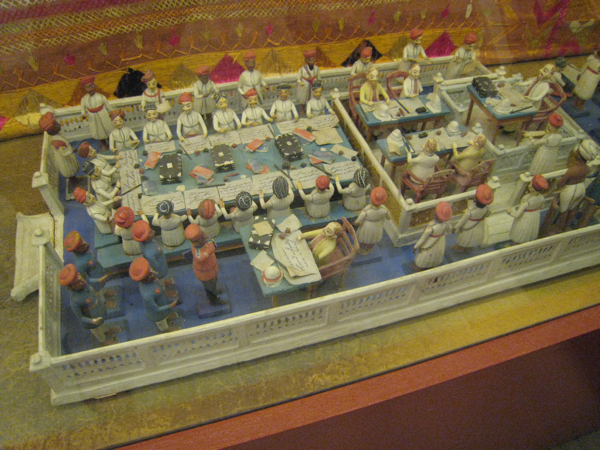I’ve been hoping for years to see this full show, but the right confluence of circumstances will have to occur. At least I have now seen some excerpts, thanks to Tom’s presence at the WOSA annual reunion I just attended in Baltimore.
Tag Archives: Indian history
Toys of Empire – Teaching Young Bengalis to be Bureaucrats of the Raj
While I was in New Mexico last weekend, Sharon and I drove to Santa Fe. The town has many museums, but we visited only one: the Museum of International Folk Art. It’s not big, but offers plenty to keep the attention. One room has drawers full of decorative panels from Bangladeshi rickshaws, and molé cloth work.
Most fascinating to me was the Girard Wing, created from the personal collection of a bi-cultural globetrotter whose taste in funky objects I completely concur with. It’s an enormous room crammed to bursting with toys, figurines, masks, and tapestries, arranged according to some interior logic of the donor, which doesn’t always make sense to the outside observer. Girard didn’t believe in labels, and I can see his point: I get distracted reading the text instead of observing the object it describes. So he put discreet little numbers on the cases, corresponding to a catalog with one terse paragraph of description per case. This was very frustrating at times – you’re left wondering: “Where is that thing from? What does it mean? Why does this mask show a person with pursed-out lips with a lizard climbing down his nose?”
And: “Why does this 18th-century Bengali story-teller’s scroll illustrating the life of Krishna feature (Indian) people and gods dressed for the French royal court in knee pants, hose, and big wigs?”
We weren’t sure if we were allowed to take photos (though there weren’t any signs saying otherwise), but I couldn’t resist snatching some shots of these.
The catalog inadequately explained that they are from Bengal, and represent scenes of the workings of the British empire – intended as educational toys, perhaps to show Bengali children the (limited) jobs that would be available to them in the British bureaucracy.
At the top of the page you can see a higher court in full session. Aren’t these guys wonderful? Look at the detail of their moustaches and beards, and the little white pith helmets on the table.
Below is a detail showing the British judge in his white jacket, with the plaintiff in the white dhoti and turban in the foreground, under the watchful gaze of a guard in blue.
Below, I think, is a low-level magistrate’s office with a “native” judge. I’m guessing from their loincloths and hairstyle that the plaintiffs are tribal people.
^ Here’s a surveyor’s office, everyone busily drawing maps – except their British supervisor (who appears to be a close relative of the judge). There’s even a guy with a rod, ready to go out and take more measurements.
Woodstock School History Resources
I’ve been doing lots of reading for the Woodstock history project, including some books that may be interesting even to non-Woodstockers. I was excited to finally lay hands on the journal of Fanny Parkes, an Englishwoman who lived in India from the 1820s to 40s. She was the first person to write about Mussoorie and Landour (the Himalayan town which is the site of the school), so is quoted in many of my sources, but her book has been out of print since 1850. It has now finally been republished (under the title “Begums, Thugs & White Mughals”), thanks, I suspect, to William Dalrymple, author of “White Mughals” (another source I’m using). Fanny was an amazing woman who travelled extensively in India and enjoyed everything and everyone she encountered, at a time when it was becoming unfashionable among the British to like anything much about the country they were taking over. Her book is rich in detail about life in India in those times, an excellent source for all kinds of research.
For current news for Mussoorie and Uttaranchal, see The Garhwal Post.








